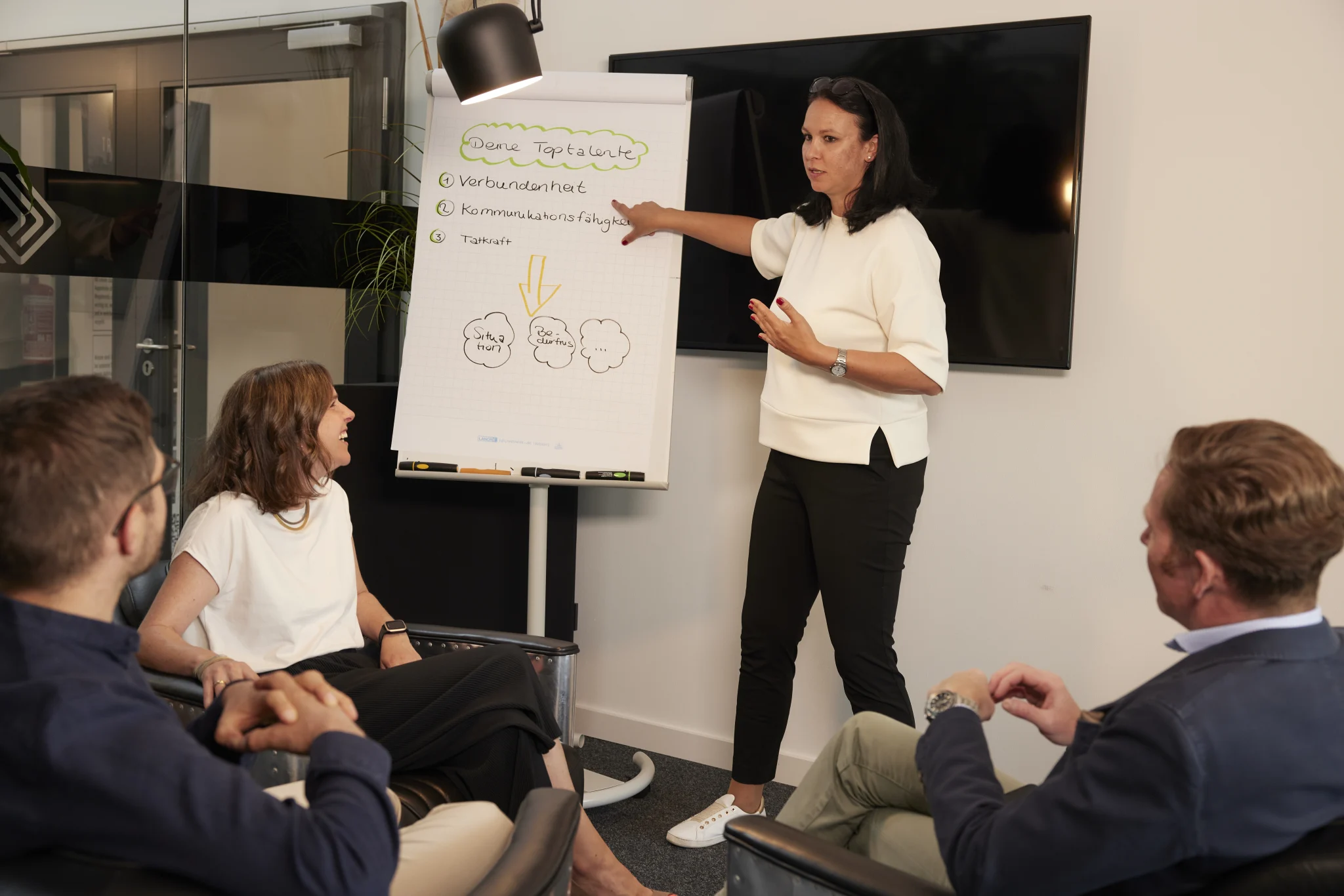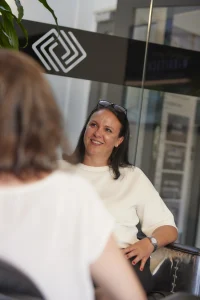Building on strengths instead of identifying weaknesses. To achieve that, we decided to focus on our strengths using the CliftonStrengths Test. Why this assessment? What advantages does it hold and how to implement it in our work?
How is it possible to enhance the understanding of the behaviors and actions of your employees? How do you foster effective partnerships and teams? How can we achieve excellent performance and greater satisfaction? The magic word here is “strengths orientation”.
It has been empirically proven that a strengths orientation in organizations also brings economic benefits. For example, employees who have been developed on the base of strengths show up to 18 % higher performance than their colleagues (measured, for instance, in productivity, performance ratings, or sales figures). This is tremendous – but only one of the multiple reasons, the WARGITSCH Transformation Engineers decided to go strengths-based with Gallup’s CliftonStrengths. Our VP Corporate Development, Dr. Christina Weigert, talks about her training as a strengths coach in this interview.

You recently completed the Gallup Global Strengths Coach training. How did the experience work?
Dr. Christina Weigert: Generally, the training consisted of several parts. First, there was a week of intensive remote training. I was curious to see how this could be realized when there were many participants and many practical exercises. But it worked out thanks to very well didactics and moderation. After the course week, it was time for self-study to prepare for the online exam. To complete the certification, I had to do six individual coaching sessions. Thankfully, I was able to draw on the support of our management team, who volunteered their time for this.
That sounds like an intense time. What highlights did you take home with you?
Dr. Christina Weigert: A special highlight in the training was the really great group of participants, which was made up of people with the most diverse backgrounds. Some self-employed people who had already worked as systemic coaches, executives in the banking sector, organizational developers, HR managers, and many more. After the very intense week with also personal exchange moments in the practice coaching sessions and an always respectful and helpful contact with each other, the group is still in contact and exchanges regularly around the topic of strength orientation. That was and still is an actual highlight within the training for me.
Why using the CliftonStrengths-Finder and not another test? After all, there are many tests and assessments to create personality types or profiles, such as the Myers-Briggs Type Indicator or the nine team roles according to Belbin.
Dr. Christina Weigert: What bothers me about it is that the result often places you in one of the predefined “compartments”. In the 16 MBTI categories, for example, I am the “consul” (ESFJ-A). As a “single percipient” (CliftonStrengths) who perceives people strongly on the individual level, this kind of categorization is a bit repugnant to me. Gallup’s CliftonStrengths finder, on the other hand, identifies value-based talent characteristics of a person’s personality as a natural, recurring pattern of thought, feeling, or behavior in a personal ranking of 34 talents. The probability of identical report results is 1:33 million and therefore highly individual. With this incomparable profile, it is possible to work in a much more differentiated way than with a template classification of people. Also appealing to me is the academic anchoring of the CliftonStrengths-Finder in Positive Psychology, which is based on the principle of drawing attention to people having a natural potential for excellence – therefore focusing on the positive and on strengths rather than on a person’s deficits and weaknesses. An example: With my “weak hand” I will never be able to write as confidently, quickly, and intuitively as with my strong hand. So with which hand should I invest in a calligraphy course? Quite clearly – with the strong one. With the weak hand, with a lot of practice, I can at best achieve mediocrity, but with the strong hand, I will be able to achieve excellent results. That is the principle of strength orientation.
In 2022, the WARGITSCH Transformation Engineers decided to integrate strengths orientation into its corporate culture. What does the roll-out of the CliftonStrengths Finder and the talent topics look like at your company in concrete terms?
 Dr. Christina Weigert: Ideally, strengths-based development begins with identifying one’s own talents, then, in a second step, appreciating them and consciously using them in the final stage. We therefore began by familiarizing all managers and employees with the concept of strengths orientation and explored everyone’s strengths profiles in various group sessions and individual formats. In this way, everyone discovers for themselves what the talent topics mean to them. In various exercises and tasks, the participants then learn to accept their talents and to appreciate their uniqueness. It is not uncommon to interpret a proven talent as a weakness in one’s previous life. If you take a closer look at this, it will become clearer where a hidden strength can actually lie. In the next step, the strengths of the team are identified in team sessions and very specifically explored, how the respective talents can be used in a very targeted manner in team cooperation and developed into an individual and collective strength. In addition, we also offer one-on-one-coaching sessions in which individual development plans are developed or specific challenges are worked on, always in line with the individual strengths profile.
Dr. Christina Weigert: Ideally, strengths-based development begins with identifying one’s own talents, then, in a second step, appreciating them and consciously using them in the final stage. We therefore began by familiarizing all managers and employees with the concept of strengths orientation and explored everyone’s strengths profiles in various group sessions and individual formats. In this way, everyone discovers for themselves what the talent topics mean to them. In various exercises and tasks, the participants then learn to accept their talents and to appreciate their uniqueness. It is not uncommon to interpret a proven talent as a weakness in one’s previous life. If you take a closer look at this, it will become clearer where a hidden strength can actually lie. In the next step, the strengths of the team are identified in team sessions and very specifically explored, how the respective talents can be used in a very targeted manner in team cooperation and developed into an individual and collective strength. In addition, we also offer one-on-one-coaching sessions in which individual development plans are developed or specific challenges are worked on, always in line with the individual strengths profile.
Nowadays, we live in a society that places a great deal of emphasis on deficits, poor grades, and failure at exams or rather the avoidance of failing them in the areas of education, work, and private life. Why would it be beneficial for us to shift to a strengths-based approach?
Dr. Christina Weigert: To answer this question, I would like to briefly address what a weakness actually is. Gallup defines “weakness” as something that gets in the way of success. More specifically, a weakness is a lack of or failure to realize talents that cause problems for us or others. Accordingly, one cannot ignore one’s weaknesses entirely. Neither does the strengths-based approach. But we will not be able to transform “non-talents” into talents. Therefore, it is only logical to search for ways to master one’s weaknesses, to manage them. For example, through support systems or a complementary partnership. In a professional context, in extreme cases, there is no way around changing the environment if it demands certain talents that I do not possess.
Let’s use an example to be able to imagine this more vividly: If, for example, the talent “competitive orientation” is not or only very weakly developed in me (i.e., the need to compete and, best of all, to always be number one) and professional success in an organization is linked to a strongly developed competitive orientation, it is very questionable whether I will be able to be truly successful here. I don’t even want to talk about being satisfied. On the contrary, it will take a lot of energy away from me. However, I can then consider what top talents I have with which I can meet certain challenges (e.g. performance orientation, self-confidence). A permanent state as a perceived penguin in the desert, however, is not goal-oriented and probably not very healthy.
Which confronts us with a major challenge, especially in the context of our educational system...
Dr. Christina Weigert: Yes, in the German education system in particular, there is unfortunately still a focus on cognitive performance and on identifying weaknesses rather than on how to build on strengths. In this regard, the now deceased education expert Sir Ken Robinson, in one of the most watched TED Talks from 2020, speaks of “a drawn-out process of a university entrance exam.” Many people who are more likely to have creative talents would be discouraged, overlooked, and filtered out as a result. This is how we are socialized over the medium term and first take this imprint into adult life. It is not surprising that there are enough people who then go into jobs that do not make them happy because there is a lack of sufficient examination of their own talents as well as the needs, shadow sides and blind spots that go with them.
Yet things could be quite different in the 21st century!
Dr. Christina Weigert: There are also other educational systems, such as in Scandinavia, which already focus more on strengths. Here, we could learn a thing or two from. But fortunately, something is also happening in companies. In my training as a strengths trainer, there were participants from a wide variety of industries and company sizes. It became clear that strengths-based management has not only found its way into modern, holocratic companies, where the approach is quite obvious. With the support of their executive boards, many large, traditional corporations have also taken up the issue and are introducing it. The relevance of the topic has been reaffirmed for me by the exchange in this heterogeneous training group and I am very pleased that we also have the open mind and commitment to it at WARGITSCH Transformation Engineers.
Is the subject of strengths orientation of interest to you as well? Do you want to bring your team closer together? If you want to improve the satisfaction and productivity of your employees on a long-term basis, please feel free to contact us: info@wargitsch.com
Sources:
Trautmann et al., On the way to New Work.
https://www.gallup.com/workplace/236927/employee-engagement-drives-growth.aspx)